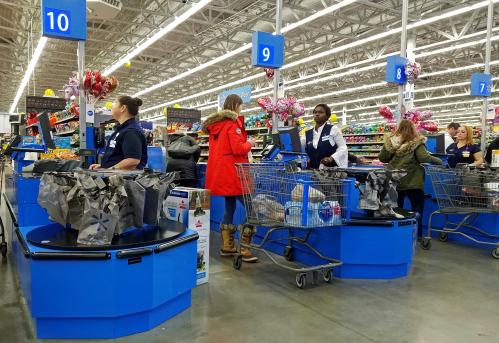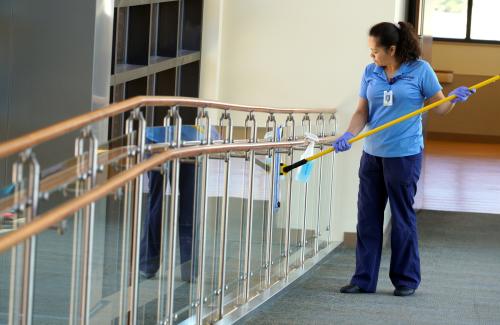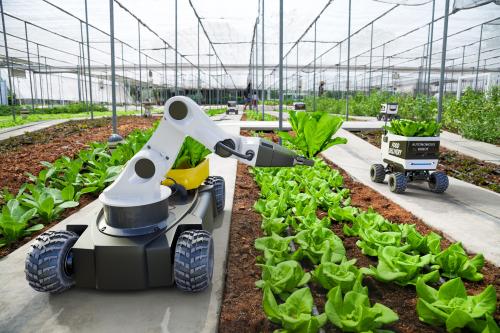If you are one of the 165 million Americans expected to shop over Black Friday weekend, chances are that technology and automation will be part of your shopping experience. If you’re shopping online, perhaps it will be an algorithm generating tips on what to buy next. But if you’re going the brick-and-mortar route, one piece of technology you’re almost sure to encounter is one that has become a bane to retail workers and a symbol of the perils of the future of work: the self-checkout lane.
Over the last year, I led a research project with a team from New America to explore how work is changing, and how front-line workers experience and view these changes. We interviewed workers across the country in the jobs most affected by technology, including retail sales workers—the most common occupation category in the country—as well as cashiers, the third most common category. Of the many advancements being deployed by retailers, self-checkout stood out as particularly reviled by workers. Their concerns illustrate the ways that new technology can reinforce and exacerbate existing inequities and struggles.
Workers voiced a range of emotions—frustration, sadness, even anger—about the impact of self-checkout machines on the displacement of workers’ hours and jobs. “I despise [self-checkout],” one retail manager told us. “You’ve eliminated four jobs.”
“I despise [self-checkout],” one retail manager told us. “You’ve eliminated four jobs.”
Despite headlines of a booming economy and record low unemployment, many retail workers still struggle to secure enough hours to pay their bills and qualify for benefits such as health insurance. Among retail workers we interviewed, many see self-checkout and similar labor-saving technologies as directly contributing to these struggles. As one cashier said: “We have eight self-checkouts at our store…They use them because they cut us out. Cut our hours, cut our manpower.”
Cashiers and retail workers we spoke to had plenty to say about the flaws of self-checkout, including the potential for theft, poor technical functionality, and a worse experience for customers. But they didn’t believe they had any say or input in how these technologies could be improved.
“[Self-checkout] is a super picky machine,” a retail cashier told us. “Do you know the show ‘Undercover Boss?’ It would be cool if our corporate people did that…If every time they went through self-checkout and something bad happened, they wouldn’t want to come here anymore.”
At our report launch event, Cordelia Cooper, a 60-year-old cashier with 41 years of experience, said that the new self-checkout system at her grocery chain, “wasn’t ergonomically right. It hurt the body. And they didn’t come and ask us, ‘Well, how is this working out?’”
Other workers noted in interviews that self-checkout didn’t truly “automate” the process, but rather simply shifted the labor onto the customer. “The customers hate self-checkout,” a retail cashier said. “I was on one of the registers and a customer said to me, ‘Well, I don’t work here, so I don’t want to ring my own stuff up.’ I was working in the self-checkout another day and a guy told me, ‘Hey, give me your discount card. I rang my own stuff up, so I work here. I should use your discount card.’ I walked away.”
Retail workers are not alone in questioning the value of self-checkout machines. In a recent paper, MIT economists Daron Acemoglu and Pascual Restrepo expounded on “so-so technologies” such as self-checkouts, which displace workers while having limited productivity benefits and questionable quality. And the authors of a recent report from the MIT Task Force on the Work of the Future cite self-checkout as an example of a technology that essentially passes on the work from cashiers to “amateur” customers. “Self-checkout kiosks likely do raise productivity by some amount, or firms would presumably stick with human workers,” the report suggests. “But the ratio of worker displacement to productivity growth for these so-so technologies is arguably less favorable than for labor-complementing innovations such as electric lighting.”
“Technology is just going,” the cashier told us. “They’re trying to figure out different things to cut costs. And so I’m the most costly thing there.”
These stories highlight another worker grievance we repeatedly heard: Self-checkout is dehumanizing to workers, and reflects their employers’ priority of the bottom line over them. The introduction of self-checkout was at odds with workers’ desire to feel like they matter in their workplaces and that their employers value their work. One cashier said she feels like just another cost that her employer is trying to eliminate. “Technology is just going,” the cashier told us. “They’re trying to figure out different things to cut costs. And so I’m the most costly thing there.”
Concerns about “so-so technologies” highlight the need for a more nuanced discussion on the future of work. While narratives around technological change and automation are often tinged with inevitability, the retail workers in our study saw things differently. They viewed the introduction of technologies such as self-checkout as deliberate choices by companies in pursuit short-run profits, and in many cases done without the involvement of workers. While the technology itself is neither good nor bad, how it is deployed can have significant impacts for workers.
To that end, we need to do more to combat the growing inequities workers face as technology and automation encroach into the workplace. This can be done through issues such as enhancing worker agency and voice, considering how firms deploy technologies, and improving the (currently inadequate) policy infrastructure, labor laws, workforce system, and safety net that should support workers. In short, far more needs to be done this holiday season to give the millions of retail workers a future of work they can be thankful for.







Commentary
Black Friday shopping season sheds light on self-checkout and the curse of ‘so-so technologies’
November 26, 2019